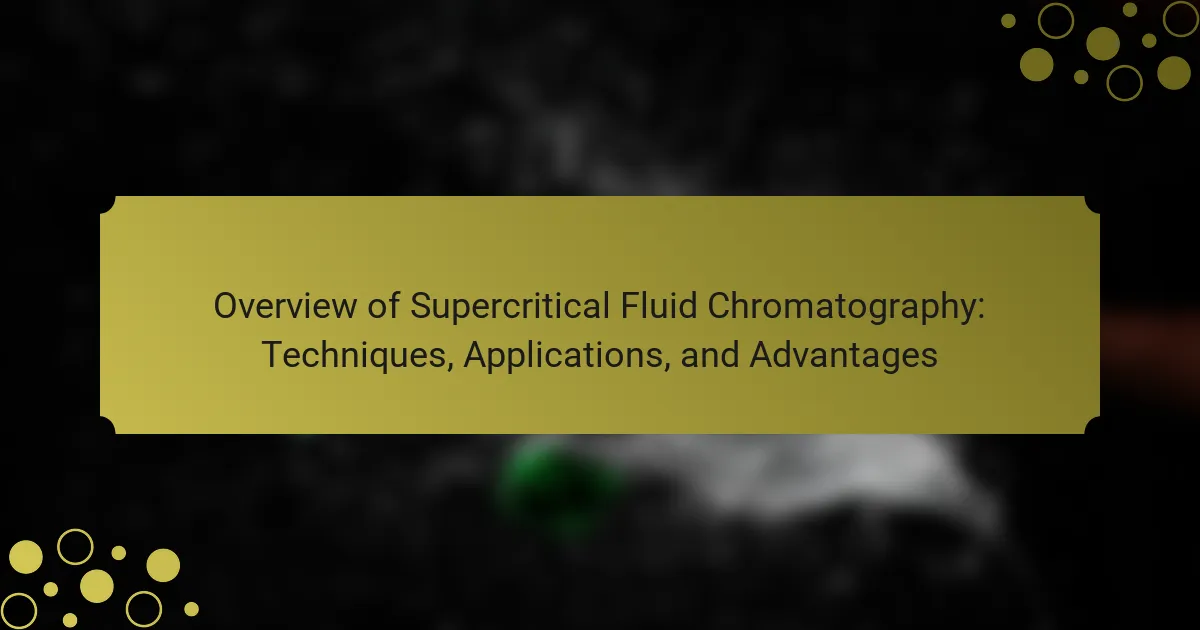Supercritical fluids are substances that exist above their critical temperature and pressure, offering unique properties beneficial for pharmaceutical manufacturing. This article explores the applications of supercritical fluids, particularly supercritical carbon dioxide, in extraction, purification, and formulation processes, highlighting their advantages such as enhanced mass transfer, improved yield, and reduced environmental impact. It also addresses challenges like high operational costs, technical complexity, and regulatory hurdles that may impede their adoption. Furthermore, the article outlines strategies for effective integration of supercritical fluid technology, including equipment investment, staff training, and process validation to ensure compliance with industry standards.

What are Supercritical Fluids and Their Role in Pharmaceutical Manufacturing?
Supercritical fluids are substances that exist above their critical temperature and pressure, exhibiting unique properties. In pharmaceutical manufacturing, they are used for extraction, purification, and formulation processes. Their low viscosity and high diffusivity enhance mass transfer, making them efficient solvents. Supercritical carbon dioxide is the most commonly used supercritical fluid due to its non-toxicity and tunable properties. This method reduces the need for organic solvents, leading to greener manufacturing practices. Studies show that using supercritical fluids can improve yield and product quality. They also enable the processing of thermally sensitive compounds without degradation.
How are supercritical fluids defined in the context of pharmaceuticals?
Supercritical fluids are defined as substances that are at a temperature and pressure above their critical points. In this state, they exhibit properties of both liquids and gases. This unique behavior allows supercritical fluids to dissolve materials like a liquid while also diffusing like a gas. In pharmaceuticals, they are used for processes such as extraction, particle formation, and formulation. For instance, supercritical carbon dioxide is commonly utilized due to its low toxicity and effective solvent properties. The use of supercritical fluids can enhance the solubility of poorly soluble drugs, improving bioavailability. Studies show that using supercritical fluids can lead to more efficient manufacturing processes and higher quality pharmaceutical products.
What are the key properties of supercritical fluids?
Supercritical fluids have unique properties that make them valuable in various applications. They exhibit characteristics of both gases and liquids. This dual nature allows for enhanced solubility and diffusion. Supercritical fluids can dissolve a wide range of substances. They have low viscosity, which facilitates easier transport and mixing. Additionally, their density can be adjusted by changing temperature and pressure. This tunability enhances their effectiveness in extraction processes. Supercritical fluids are also environmentally friendly, often requiring fewer solvents. These properties support their use in pharmaceutical manufacturing processes, such as extraction and formulation.
How do supercritical fluids differ from traditional solvents?
Supercritical fluids differ from traditional solvents in their unique state that combines properties of both gases and liquids. Supercritical fluids, like carbon dioxide, have a density similar to liquids but can diffuse through solids like gases. This allows for enhanced solubility and extraction capabilities. Traditional solvents, on the other hand, are typically either liquid or gas and do not possess this dual characteristic. Supercritical fluids can be easily manipulated by adjusting temperature and pressure, allowing for precise control over extraction processes. In contrast, traditional solvents have fixed boiling points and vapor pressures. This versatility makes supercritical fluids more efficient for certain applications, such as extracting active pharmaceutical ingredients. Studies have shown that supercritical fluid extraction can yield higher purity and better recovery rates compared to traditional solvent methods.
What processes utilize supercritical fluids in pharmaceutical manufacturing?
Supercritical fluids are utilized in various processes in pharmaceutical manufacturing. These processes include extraction, where supercritical carbon dioxide extracts active ingredients from plant materials. Another process is particle formation, which produces nanoparticles for drug delivery systems. Supercritical fluid chromatography is also employed for the separation and purification of compounds. Additionally, supercritical fluids are used in the formulation of drug products to enhance solubility and bioavailability. These applications leverage the unique properties of supercritical fluids, such as low viscosity and high diffusivity, to improve efficiency and effectiveness in pharmaceutical production.
What are the main applications of supercritical fluids in drug formulation?
Supercritical fluids are utilized in drug formulation primarily for extraction, particle size reduction, and solvent-free processing. They effectively extract active pharmaceutical ingredients from natural sources, enhancing yield and purity. Supercritical carbon dioxide is commonly used due to its favorable properties, such as low toxicity and tunable solubility. The technology allows for the production of nanoparticles, which improve drug solubility and bioavailability. Additionally, supercritical fluids facilitate the formulation of solid dispersions, enhancing the stability of poorly soluble drugs. The application of this method reduces the need for organic solvents, promoting environmentally friendly practices in pharmaceutical manufacturing.
How is supercritical fluid extraction performed in pharmaceutical processes?
Supercritical fluid extraction (SFE) in pharmaceutical processes involves using supercritical fluids, typically carbon dioxide, to extract active compounds. The process begins by placing the raw material in an extraction vessel. The supercritical fluid is then introduced under high pressure and temperature. This state allows the fluid to penetrate the material and dissolve the desired compounds.
After sufficient extraction time, the pressure is reduced, causing the supercritical fluid to revert to gas. This change facilitates the separation of the extracted compounds from the fluid. The extracted substances can then be collected for further processing. SFE is favored for its efficiency and ability to preserve sensitive compounds. Studies show that SFE can enhance yield while minimizing solvent residues in pharmaceutical products.
What are the benefits of using supercritical fluids in pharmaceuticals?
Supercritical fluids provide several benefits in pharmaceuticals. They enhance the solubility of compounds, allowing for better drug formulation. Supercritical carbon dioxide is non-toxic and environmentally friendly. This fluid can extract active pharmaceutical ingredients efficiently. It operates at lower temperatures, preserving heat-sensitive compounds. The process reduces the need for organic solvents. This leads to a safer manufacturing environment. Additionally, supercritical fluids can improve bioavailability of drugs. Studies show increased efficacy in drug delivery systems when using supercritical fluids.
How do supercritical fluids enhance drug solubility and bioavailability?
Supercritical fluids enhance drug solubility and bioavailability by altering the solvation properties of compounds. They possess unique characteristics, such as low viscosity and high diffusivity. These properties allow supercritical fluids to dissolve a wide range of substances, including poorly soluble drugs. The high density of supercritical fluids increases the solubility of active pharmaceutical ingredients. This leads to improved drug dispersion in biological systems. Studies show that using supercritical carbon dioxide can significantly enhance the bioavailability of certain medications. For example, research indicates that supercritical fluid technology can increase the solubility of hydrophobic drugs by up to 100 times. Enhanced solubility directly correlates with improved absorption rates in the body. Thus, supercritical fluids serve as effective mediums for drug formulation, leading to better therapeutic outcomes.
What advantages do supercritical fluids offer in terms of environmental impact?
Supercritical fluids offer significant advantages in terms of environmental impact. They reduce the need for organic solvents in pharmaceutical processes. This minimizes hazardous waste generation, leading to a smaller ecological footprint. Supercritical fluids also enable efficient extraction processes, utilizing less energy compared to traditional methods. Their tunable properties allow for selective extraction, reducing the need for multiple solvents. Additionally, supercritical carbon dioxide is non-toxic and can be recycled, further decreasing environmental harm. Studies indicate that using supercritical fluids can lower greenhouse gas emissions in manufacturing processes. These factors collectively highlight the positive environmental implications of supercritical fluid technologies.

What challenges are associated with the use of supercritical fluids in pharmaceuticals?
The challenges associated with the use of supercritical fluids in pharmaceuticals include high operational costs and technical complexity. Supercritical fluid technology requires specialized equipment, which increases initial investment. The processes involved often demand precise control of temperature and pressure, complicating operations. Additionally, scaling up from laboratory to industrial applications can be difficult. Some pharmaceutical compounds may also exhibit low solubility in supercritical fluids, limiting their applicability. Moreover, regulatory hurdles can arise due to the novelty of this technology. Overall, these challenges can hinder widespread adoption in the pharmaceutical industry.
What technical challenges arise during the implementation of supercritical fluid processes?
Technical challenges during the implementation of supercritical fluid processes include equipment design, pressure control, and solute recovery. Equipment must withstand high pressures and temperatures, which complicates design and material selection. Precise pressure control is crucial to maintain the supercritical state, requiring advanced instrumentation. Solute recovery poses challenges due to the solubility variations in supercritical fluids. Additionally, scalability from laboratory to industrial scale can introduce operational complexities. These challenges can affect efficiency and cost-effectiveness in pharmaceutical manufacturing.
How does equipment cost affect the adoption of supercritical fluid technology?
Equipment cost significantly impacts the adoption of supercritical fluid technology. High initial investment can deter manufacturers from implementing this advanced process. Equipment costs can range from tens of thousands to millions of dollars. This substantial financial barrier often leads to hesitation in adoption. Additionally, ongoing maintenance and operational costs can further complicate financial feasibility. Companies may prioritize more cost-effective alternatives if they perceive supercritical fluid technology as too expensive. Studies indicate that lower equipment costs can enhance adoption rates. For instance, advancements in technology have reduced costs by up to 30% in recent years. Thus, equipment cost is a critical factor influencing the willingness to adopt supercritical fluid technology in pharmaceutical manufacturing.
What are the limitations regarding scalability in pharmaceutical manufacturing?
Scalability in pharmaceutical manufacturing is limited by several factors. Equipment constraints often restrict the ability to increase production volumes. Process optimization can be challenging due to the complexity of formulations. Regulatory compliance requires extensive validation, which can slow down scaling efforts. Additionally, raw material availability may hinder the ability to scale up production. Economic factors, such as cost of production and market demand, also play a critical role. These limitations can impact the overall efficiency and feasibility of scaling pharmaceutical manufacturing processes.
What regulatory and safety considerations must be addressed?
Regulatory and safety considerations in pharmaceutical manufacturing with supercritical fluids include compliance with Good Manufacturing Practices (GMP). GMP regulations ensure that products are consistently produced and controlled according to quality standards. Additionally, safety assessments must evaluate the toxicity and environmental impact of supercritical fluids used in processes.
The Occupational Safety and Health Administration (OSHA) guidelines must be followed to protect workers from exposure to hazardous materials. Furthermore, the Environmental Protection Agency (EPA) regulates the disposal and emissions of supercritical fluids to mitigate environmental risks.
Documentation and validation of processes are essential to demonstrate compliance with regulatory standards. The U.S. Food and Drug Administration (FDA) also requires that pharmaceutical products undergo rigorous testing to ensure safety and efficacy. These considerations are crucial for maintaining product integrity and public health.
How do regulations impact the use of supercritical fluids in drug development?
Regulations significantly influence the use of supercritical fluids in drug development. They establish safety and efficacy standards that must be met. Compliance with these regulations ensures that supercritical fluid processes are safe for human use. Regulatory agencies, such as the FDA, require detailed documentation of methods and outcomes. This includes data on the purity of compounds produced using supercritical fluids. Additionally, regulations may dictate the types of solvents and conditions permissible in drug manufacturing. Adhering to these guidelines can impact the timelines and costs associated with drug development. Ultimately, regulations aim to protect public health while fostering innovation in pharmaceutical manufacturing.
What safety protocols are necessary when working with supercritical fluids?
Safety protocols when working with supercritical fluids include proper training, use of personal protective equipment, and equipment integrity checks. Workers must be trained in handling supercritical fluids due to their high pressure and temperature. Personal protective equipment, such as gloves and goggles, is essential to prevent exposure. Regular inspections of equipment are necessary to prevent leaks and failures. Ventilation systems should be in place to disperse any accidental releases. Emergency procedures must be established and practiced. Material compatibility must be ensured to prevent reactions. Safety data sheets for the fluids used should be readily accessible. These protocols are critical to minimize risks associated with supercritical fluid operations.

How can pharmaceutical manufacturers effectively integrate supercritical fluids?
Pharmaceutical manufacturers can effectively integrate supercritical fluids by adopting specific processes and technologies. First, they should evaluate the suitability of supercritical fluid extraction (SFE) for their products. SFE can enhance the extraction of active pharmaceutical ingredients (APIs) with improved purity and yield. Next, manufacturers need to invest in specialized equipment designed for supercritical fluid processes. This includes high-pressure pumps and separators that can handle the unique properties of supercritical fluids.
Training staff on the operation and maintenance of this equipment is essential. Knowledgeable personnel can optimize the integration process and troubleshoot issues. Additionally, manufacturers should conduct thorough process validation to ensure consistent results. This involves rigorous testing to confirm that supercritical fluid techniques meet regulatory standards.
Implementing supercritical fluid technology can lead to reduced solvent usage and lower environmental impact. Studies show that supercritical CO2 is a green solvent alternative, minimizing waste compared to traditional methods. By following these steps, pharmaceutical manufacturers can successfully integrate supercritical fluids into their production processes.
What best practices should be followed for successful implementation?
Successful implementation of supercritical fluids in pharmaceutical manufacturing requires careful planning and execution. First, conduct a thorough feasibility study to assess the suitability of supercritical fluid technology for specific applications. Next, ensure proper training for personnel involved in the process. This training should cover both operational and safety protocols.
Additionally, maintain stringent quality control measures throughout the implementation phase. Regular monitoring of process parameters is essential to ensure consistency and reliability. Collaborate closely with equipment manufacturers to customize technologies for specific needs.
Finally, document all processes and results meticulously to facilitate future improvements and regulatory compliance. These practices have been shown to enhance efficiency and reduce risks in pharmaceutical manufacturing.
How can manufacturers optimize the extraction process using supercritical fluids?
Manufacturers can optimize the extraction process using supercritical fluids by adjusting temperature and pressure settings. This allows for enhanced solubility of target compounds. Utilizing co-solvents can also increase extraction efficiency. Additionally, optimizing the flow rate of the supercritical fluid improves mass transfer rates. Implementing continuous extraction systems can lead to higher throughput. Employing advanced monitoring technologies ensures precise control over extraction parameters. Research shows that these methods can significantly enhance yield and purity of extracted compounds. For instance, studies indicate that optimizing these variables can increase extraction efficiency by up to 30%.
What common troubleshooting techniques can be applied in supercritical fluid operations?
Common troubleshooting techniques in supercritical fluid operations include adjusting temperature and pressure parameters. These adjustments can optimize solubility and extraction efficiency. Monitoring flow rates is also crucial. Inconsistent flow can lead to operational issues. Regular maintenance of equipment helps prevent malfunctions. Analyzing the composition of the supercritical fluid can identify impurities. Conducting routine checks on system seals prevents leaks. Implementing a systematic approach to data logging aids in identifying trends. These techniques enhance overall operational reliability and efficiency in supercritical fluid processes.
What future developments can be expected in the use of supercritical fluids?
Future developments in the use of supercritical fluids include enhanced extraction techniques and improved formulation methods. Researchers are focusing on optimizing supercritical fluid extraction (SFE) to increase yield and selectivity of active pharmaceutical ingredients. Innovations in equipment design are expected to reduce energy consumption and operational costs. Advances in computer modeling will enable better prediction of fluid behavior under various conditions. Additionally, the integration of supercritical fluids with other technologies, such as ultrasound and microwave assistance, may enhance extraction efficiency. Regulatory frameworks are also evolving to better accommodate supercritical fluid technologies in pharmaceutical applications. These developments aim to make supercritical fluid processes more sustainable and commercially viable.
How might advancements in technology impact supercritical fluid applications?
Advancements in technology may significantly enhance supercritical fluid applications. Improved equipment design can increase efficiency and reduce costs. Enhanced sensors and control systems allow for better monitoring of supercritical fluid processes. This leads to increased precision in pharmaceutical manufacturing. New materials can withstand higher pressures and temperatures, expanding the range of applications. Automation and machine learning can optimize process parameters in real-time. Research shows that these advancements can improve product quality and yield. Overall, technology plays a crucial role in advancing supercritical fluid applications in the pharmaceutical industry.
What emerging trends are influencing the pharmaceutical industry’s approach to supercritical fluids?
Emerging trends influencing the pharmaceutical industry’s approach to supercritical fluids include increased focus on sustainability and efficiency. Companies are adopting supercritical fluid technology to reduce solvent waste and minimize environmental impact. Advances in equipment design are enabling more efficient extraction and formulation processes. Additionally, the integration of real-time monitoring technologies is enhancing process control and product quality. Research indicates that supercritical fluids can improve bioavailability of drugs, leading to more effective formulations. The trend towards personalized medicine is also driving interest in supercritical fluid applications for tailored drug delivery systems.
Supercritical fluids, particularly supercritical carbon dioxide, play a crucial role in pharmaceutical manufacturing due to their unique properties, such as low viscosity and high diffusivity. These fluids are utilized in various processes including extraction, purification, and formulation, enhancing drug solubility and bioavailability while promoting environmentally friendly practices. The article explores the benefits of supercritical fluids, such as improved yield and product quality, along with the challenges faced in their implementation, including high operational costs and regulatory considerations. Additionally, it discusses best practices for integrating supercritical fluid technologies into pharmaceutical production and the future developments expected in this field.



